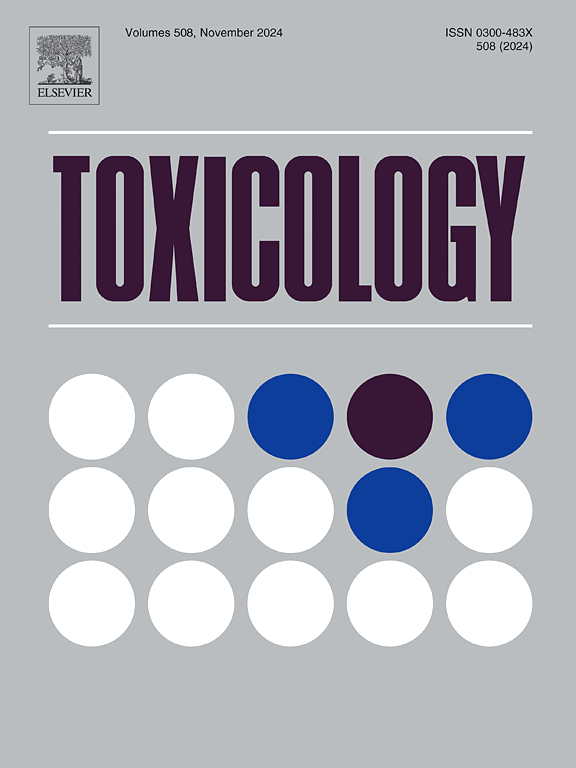镰刀菌毒素对人体免疫细胞的免疫毒性作用及其机制:以T细胞和巨噬细胞为重点
IF 4.6
3区 医学
Q1 PHARMACOLOGY & PHARMACY
引用次数: 0
摘要
镰刀菌毒素,包括脱氧雪腐镰刀菌醇(DON)、15-乙酰-脱氧雪腐镰刀菌醇(15-Ac-DON)、3-乙酰-脱氧雪腐镰刀菌醇(3-Ac-DON)和雪腐镰刀菌醇(NIV),是食品和动物饲料中普遍存在的污染物,对人类健康构成重大风险。虽然免疫毒性被认为是DON暴露的一个敏感终点,但其乙酰化衍生物和NIV的免疫毒性作用和机制,特别是在人源性免疫细胞中的免疫毒性作用尚未完全阐明。在这项研究中,我们探讨了这些真菌毒素对人体免疫细胞的毒理学影响及其机制,重点是T细胞和巨噬细胞。用四种真菌毒素(0-5000 nM)处理人源性细胞模型48 h后,Jurkat T细胞对这些真菌毒素的敏感性提高,其中NIV表现出最高的细胞毒性,其次是DON, 15-Ac-DON和3-Ac-DON。值得注意的是,在低暴露水平(0-200 nM)下,这四种真菌毒素剂量依赖性地抑制了外周血单核细胞(PBMCs)模型中人T细胞的激活。同样,用NIV(0-500 nM)、DON(0-1000 nM)和15-Ac-DON(0-1000 nM)处理巨噬细胞48 h后,观察到巨噬细胞选择性活化、溶酶体生物合成和细胞因子产生的剂量依赖性抑制。转录组学分析表明,DON、15-Ac-DON和NIV破坏T细胞和巨噬细胞中的核糖体生物发生和蛋白质加工途径。这些发现强调了化学结构对镰刀菌毒素毒性的影响,并为其免疫毒性机制提供了重要的见解。本文章由计算机程序翻译,如有差异,请以英文原文为准。
Immunotoxic effect and mechanisms of Fusarium mycotoxins on human immune cells: A focus on T cells and macrophages
Fusarium mycotoxins, including deoxynivalenol (DON), 15-acetyl-deoxynivalenol (15-Ac-DON), 3-acetyl-deoxynivalenol (3-Ac-DON), and nivalenol (NIV), are prevalent contaminants in food and animal feed, posing significant health risks to humans. Although immunotoxicity is acknowledged as a sensitive endpoint for DON exposure, the immunotoxic effects and mechanisms of its acetylated derivatives and NIV, especially in human-derived immune cells, are not fully elucidated. In this study, we explored the toxicological impacts and mechanisms of these mycotoxins on human immune cells, with a focus on T cells and macrophages. After treating human-derived cell models with four fungal toxins (0–5000 nM) for 48 h, Jurkat T cells showed heightened sensitivity to these mycotoxins, with NIV exhibiting the highest cytotoxicity, followed by DON, 15-Ac-DON, and 3-Ac-DON. Notably, these four mycotoxins dose-dependently inhibited the activation of human T cells in the Peripheral Blood Mononuclear Cells (PBMCs) model at much lower exposure levels (0–200 nM). Similarly, after treating macrophages with NIV (0–500 nM), DON (0–1000 nM), and 15-Ac-DON (0–1000 nM) for 48 h, dose-dependent inhibition of macrophage alternative activation, lysosomal biosynthesis, and cytokine production were observed. Transcriptomic analyses indicated that DON, 15-Ac-DON, and NIV disrupt ribosome biogenesis and protein processing pathways in both T cells and macrophages. These findings underscore the influence of chemical structure on the toxicity of Fusarium mycotoxins and provide critical insights into their immunotoxic mechanisms.
求助全文
通过发布文献求助,成功后即可免费获取论文全文。
去求助
来源期刊

Toxicology
医学-毒理学
CiteScore
7.80
自引率
4.40%
发文量
222
审稿时长
23 days
期刊介绍:
Toxicology is an international, peer-reviewed journal that publishes only the highest quality original scientific research and critical reviews describing hypothesis-based investigations into mechanisms of toxicity associated with exposures to xenobiotic chemicals, particularly as it relates to human health. In this respect "mechanisms" is defined on both the macro (e.g. physiological, biological, kinetic, species, sex, etc.) and molecular (genomic, transcriptomic, metabolic, etc.) scale. Emphasis is placed on findings that identify novel hazards and that can be extrapolated to exposures and mechanisms that are relevant to estimating human risk. Toxicology also publishes brief communications, personal commentaries and opinion articles, as well as concise expert reviews on contemporary topics. All research and review articles published in Toxicology are subject to rigorous peer review. Authors are asked to contact the Editor-in-Chief prior to submitting review articles or commentaries for consideration for publication in Toxicology.
 求助内容:
求助内容: 应助结果提醒方式:
应助结果提醒方式:


